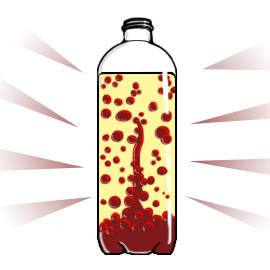‘Blobs in a bottle’ is a great science experiment to do with children in order to explore the term molecular polarity and what it means.
to explore the term molecular polarity and what it means.
To begin the experiment you must pour 200 millilitres of water into a clear 1 litre bottle of water. Afterwards you must add 700 millilitres of vegetable oil. After a few minutes, the oil will settle and will sit on top of the water with a clear separation. This is called molecular polarity. This term basically means that the two substances can not mix; The water molecules are attracted to the other water molecules and the oil molecules are attracted to the other water molecules. Due to the structure of the two different molecules, it does not allow them to bond together hence the clear division of the substances.
To make this experiment more interesting for the children, you can add any colour of food colouring into the bottle – I found red to be the best as it was a strong colour. The food colouring will drop through the oil and will mix with the water. After the colour is as strong as
you want it, you can move onto the next step and add a fizzing tablet, i.e. an Alka Seltzer, into the bottle. When the fizzing tablet dissolves it creates a gas. As the gas bubbles rise, they take some coloured water with them. Once the blob reaches the top, the gas escapes and the coloured water then sinks back down.
This process looks just like a lava lamp which can look even more effective if a light is placed underneath the bottle. This is a great experiment for kids as they are creating something they may have at home while learning about molecular polarity and how their home-made lava lamp works. This experiment will effectively engage the children in their learning as it’s something they will enjoy doing at home or within the classroom.

